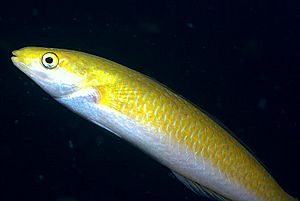Oxyjulis facts for kids
Quick facts for kids Oxyjulis |
|
|---|---|
 |
|
| Conservation status | |
| Scientific classification | |
| Synonyms | |
|
The Oxyjulis californica is a type of fish known as a wrasse. It lives in the eastern Pacific Ocean, along the coasts of California and Baja California. You can find it from Salt Point in northern California all the way down to Cedros Island in southern Baja California. This fish is very common, and its popular name in Spanish is señorita.
Contents
About the Señorita Fish
What Does It Look Like?
This fish can grow up to 25 cm (9.8 in) long. Its body is shaped like a cigar, which means it's long and slender. The top of the fish is brown or shiny bronze. Its sides are orange, and its belly is a lighter color. Near its tail fin, there's a big black or dark brown spot. The señorita fish has a small mouth with "buck teeth" that stick out. It uses these teeth to scrape tiny creatures off kelp for food.
Where Does It Live?
Señorita fish live near the coast in the ocean. They especially like kelp forests and reefs. These fish have been seen as deep as 73 m (240 ft). However, they usually live in shallower waters, about 20 m (66 ft) deep or less.
How It Behaves
Sometimes, señorita fish swim together in small groups. If they feel threatened, they often hide by digging into the sand or mud at the bottom of the ocean. They also rest on the bottom at night. They burrow backwards into the sand, so only their head sticks out.
What the Señorita Fish Eats
Its Daily Meals
The señorita fish eats many small ocean creatures. Its diet includes marine worms, tiny animals called bryozoans, and different types of crustaceans. It also eats small snails, limpets, baby fish, and squid. Sometimes, it even eats a little bit of seaweed.
The Cleaner Fish Role
One of the most interesting things about the señorita fish is that it's a cleaner wrasse. This means it helps other fish by cleaning them! It removes and eats tiny parasites and other things from their bodies. These parasites can be bacteria, small crustaceans like copepods, or isopods. Parasites can make up about half of the señorita's food.
When a señorita fish starts cleaning, other fish often gather around. They want to get cleaned too! Many different fish ask for this service. Some examples include the bat ray, giant sea bass, kelp bass, jacksmelt, topsmelt, sargo, blacksmith, garibaldi, opaleye, halfmoon, and even the huge mola.
How Fish Ask for Cleaning
Other fish have special ways of asking the señorita for cleaning.
- The garibaldi will open its gill slits wide. This lets the señorita reach parasites on its gills.
- The blacksmith points its head down to show it wants to be cleaned. Many blacksmith fish might crowd around, trying to get the señorita's attention. They might even block its way if it tries to leave!
- The opaleye usually swims all the time. But it will stop and stay still when it meets a señorita.
- The kelp bass is a predator that eats small fish. But it often avoids eating the señorita and lets it clean instead.
Staying Safe from Predators
Even though the señorita often cleans large, predatory fish, it's not always safe. It has been found in the diet of the kelp bass, bocaccio, and starry rockfish. However, it's not eaten as often as you might expect, especially since it's so close to predators. Maybe it doesn't taste good to them! Other animals that eat the señorita fish include Brandt's cormorant (a type of bird) and the California sea lion.
Reproduction and Life Cycle
Scientists don't know everything about how the señorita fish reproduces. Some think that females can change sex and become males. This is called protogynous hermaphroditism. However, others are not sure if this happens with this specific fish. The fish lay their eggs between May and August. These eggs are pelagic, which means they float freely in the water.
Life and Survival
Finding Their Way Home
Señorita fish tend to go back to their favorite spots. In one experiment, scientists caught señoritas and released them far away. Most of them were able to find their way back to their original homes.
Señorita Fish and Humans
Fishermen usually don't try to catch señorita fish. In fact, they can be a bit annoying because they often steal bait from fishing hooks! While you can technically eat them, they are not considered a valuable fish for food.
See also
 In Spanish: Oxyjulis californica para niños
In Spanish: Oxyjulis californica para niños


